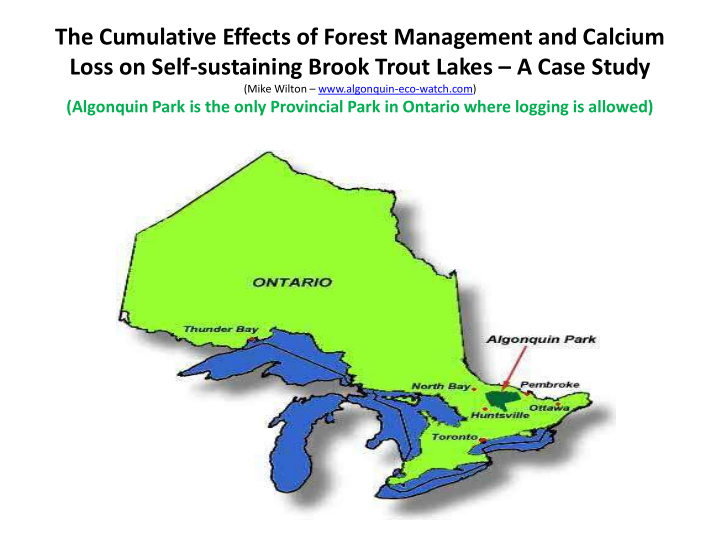



The Cumulative Effects of Forest Management and Calcium Loss on Self-sustaining Brook Trout Lakes – A Case Study (Mike Wilton – www.algonquin-eco-watch.com) (Algonquin Park is the only Provincial Park in Ontario where logging is allowed)
The Algonquin “Dome” – Looking Northwest Moist Granic Soils, Shade tolerant hardwood forest to the west – Drier Sandy Soils, Pine/poplar forest to the east
There are more than 250 identified self-sustaining (lacustrine) brook trout lakes in Algonquin Provincial Park – The highest concentration in the world.
Tiny headwater lakes like these require upwellings of cold groundwater through gravel substrate for spawning, plus inflowing coldwater “nursery “ creeks, to support self -sustaining brook trout populations.
Groundwater Follows the Earth’s Natural Topography, also known as the “Nap 0f the Earth” Similarly, if undisurbed, groundwater Groundfog follows the above ground follows the natural topography below the surface of the ground (“A” below). When natural topography (below). disturbed however, the groundwater seeks a new level (“B” below).
Groundwater Will Always Seek Its Own Level Layered Fractured Granite Layered Fractured Limestone illustrating interrupted illustrating interrupted groundwater flow. groundwater flow.
Self-sustaining Headwater Brook Trout Lakes Stylized self-sustaining (lacustrine) brook trout lake showing Actual Algonquin Park headwater lake (centre , facing north) located at a height-of-land. No visible above-ground inflow; spawning bed provided by groundwater upwelling via a lens year-round outflow to the south. Expected groundwater through clean gravel (aggregate), which is necessary for source from glacial deposit (esker?) at northwest corner of successful spawning of brook trout. Also, 3 inflowing lake. Lakes to the north flow northward. Spills from logging potential nursery creeks, which are beneficial for upstream haul-road around lake margin could result in long-term migration of fry, in order to escape predation during their pollution owing to low flushing rate in headwater lakes, which first year of life. by definition, are situated at upper end of flowage.
Source Waters Headwaters sourcing from surface water (left) often give rise to “warmwater” creeks, while headwaters sourcing from groundwater (right) usually give rise to “coldwater” creeks. Active coldwater nursery creeks may have an above ground flow of less than 1 litre per minute. Disturbance of any kind may disrupt this flow.
EFFECT OF AGGREGATE REMOVAL ON GROUNDWATER FLOW STYLIZED SCENARIO: When vegetation and mass are removed from a Actual Example: Recurrent heavy logging glacial aggregate source supplying groundwater to a self-sustaining brook and aggregate removal adjacent to this trout lake, lowering the nap of the earth results in a lower water table, Algonquin park headwater lake will which in turn diminishes groundwater flow necessary for successful brook inevitably result in cumulative reduced trout reproduction and rearing. groundwater flow, as well as higher water temperature. (See next slide)
Serious Lack of Headwater Protection Red pine seed tree logging together with an elevated Seen from ground level, it can be better understood why the aggregate pit located closely adjacent to this Algonquin Park continued mining of this aggregate source will negatively headwater lake. Repeated extraction of timber and aggregate affect the adjacent groundwater table significantly. over time will inevitably result in cumulative groundwater flow reduction. (See adjacent photo)
Tiny Headwater Lakes and Aggregate Pits These 3 tiny headwater lakes give rise to a permanent coldwater stream. While it is now too late to monitor change in this instance, aggregate mining for logging road construction within the catchment areas of these lakes, as shown, has very likely given rise to negative changes in cold groundwater flow patterns.
Calcium Deficiency Thousands of tonnes of airborne acidic sulphur dioxide travel to and over the Algonquin Ecosystem from the Sudbury Basin annually on prevailing north-westerly winds. This results in calcium deficiency in poorly buffered granitic soils, leading not only to reduced forest growth through successive rotational timber harvests, but also to a diminished aquatic food chain.
Species Change in Planktonic Crustaceans due to Calcium Loss from Acid Precipitation. Invasive, unpalatable, calcium-poor Calcium-rich (preferred food) Holopedium increasing, causing Daphnia disappearing due to lack imbalance in the aquatic food web. of available calcium.
Some Cumulative Effects of Logging on Self-sustaining Brook Trout Lakes Through Repeated Logging Rotations -Stream and lake sedimentation (from machinery disturbance). -Water temperature elevation (from canopy removal). -Soil compaction ( from heavy machinery). -Rutting (from heavy machinery). -Calcium loss (from airborne pollutants on non-buffered granitic soils), resulting from repeated logging extraction. -Aggregate mining (for road building and maintenance). -Soil pollutants (from diesel fuel, coolant, hydraulic fluid). - Elevated conductivity (from winter road salt).
What’s the Solution? The only certain way to ensure sustainability of self-sustaining (lacustrine) brook trout lakes in protected areas such as Algonquin Provincial Park, is to prohibit all logging and associated operations within the encircling catchment basin. This would also serve to promote old growth while reducing calcium loss.
In an effort to initiate public dialogue, Algonquin Eco Watch erected 4 highway signs, 2 on Hwy 60 and 1 each on Hwy 17 and the Achray Road leading into Algonquin Park.
Recommend
More recommend